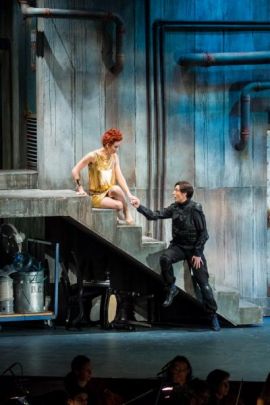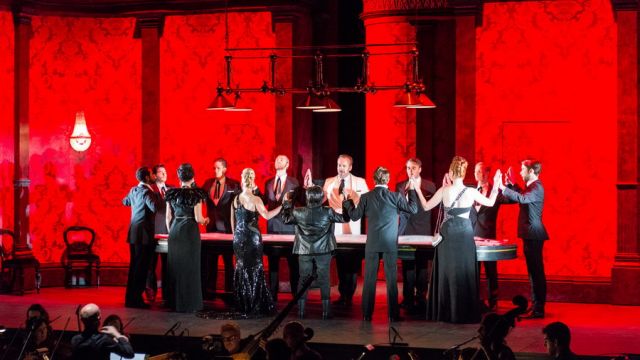Faramondo
This presentation of Handel's last great opera is a fitting introduction to Brisbane Baroque 2015. With some demanding vocal virtuosity suitable in the main only for well-trained professionals, it demonstrates the composer in the prime of his style and is a fascinating exponent for those wishing to step back in time and experience what artistic talents (including the great castrato Caffarelli playing the title role) abounded in 1738, the year of its first performance.
Full of vengeance and pity, the adaption of Zeno's 1699 libretto by an anonymous poet is a convuluted plot with a somewhat weak libretto enhanced, though, by this contemporary production, similar to the 'neo-reinvented-reworks' cropping up in Europe, particularly in Germany, around the Seventies. This time, though, Director Paul Curran has cleverly intertwined the feud between the traditional sixteenth century families with a touch of twentieth century mafioso.
 Using unusual characters: a villainous counter-tenor who has a cross-dressing fetish and, of course, females playing male roles, as was popular in Europe in the sixteenth and seventeenth centuries, this production has enough redress to capture modern audiences with a taste for the bizarre: a quasi Hollywood action hero being sung by a mezzo-soprano, a 'straight' matinee idol male role being sung by yet another counter-tenor and extras dressed in enough high-tech low-life contemporary garb to have George Frideric turning in his grave, all cemetery parties aside. Crime and passion this is indeed, including even one-arm bandits as part of the set in Act 2.
Using unusual characters: a villainous counter-tenor who has a cross-dressing fetish and, of course, females playing male roles, as was popular in Europe in the sixteenth and seventeenth centuries, this production has enough redress to capture modern audiences with a taste for the bizarre: a quasi Hollywood action hero being sung by a mezzo-soprano, a 'straight' matinee idol male role being sung by yet another counter-tenor and extras dressed in enough high-tech low-life contemporary garb to have George Frideric turning in his grave, all cemetery parties aside. Crime and passion this is indeed, including even one-arm bandits as part of the set in Act 2.
However, as with opera in general, the accent is on the music and the acclaimed international cast performed Handel's difficult virtuosic score with aplomb and style, complete with the multitude of trills, ornaments et al so typical of the era. Christopher Lowrey's grimacing portrayal of Gernando was acutely effective with a female countenance, macho male outfit coupled with a counter-tenor vocalise similar to a machine gun in full flood. And guns there were in this production: they were everywhere. This aggression, at times, matched Handel's gushing counterpoint and extreme use of vocal range almost to the point of over-bearance, but this is an opera about human extremes so artistic licence can be granted including the fact this is all combined with history in-the-making. Jennifer Rivera's Faramondo demonstrated depth of character coupled with some stunning vocal exposition as with Anna Devin as Clotilde and Anna Starushkevych's charismatic performance as Rosimonda. Jeremy Kleeman, a graduate of Victorian Opera, also gave a moving performance as Teobaldo. With a rich baritone voice this is an artist well worth keeping an eye on.
But even more in the spotlight was Erin Helyard's passionate and animated dual performance on the harpsichord and as conductor for the very capable Orchestra of the Antipodes and captivating cast.
Handel was adept at keeping up with the times, and it's not surprising his style of music became more popular in oratorios over time, something we can appreciate now having experienced more accomplished styles of musical theatre over the ages. I have never aspired to the bulk of Handel's musical style as being suitable for staged theatre, but despite this sentiment I found Faramondo to be an intriguing interpretation of a difficult work using a juxtaposition of styles and symbolism in a well-conceived production displaying, in particular, some very fine vocal technique.
Brian Adamson
Images by Darren Thomas
Subscribe to our E-Newsletter, buy our latest print edition or find a Performing Arts book at Book Nook.

